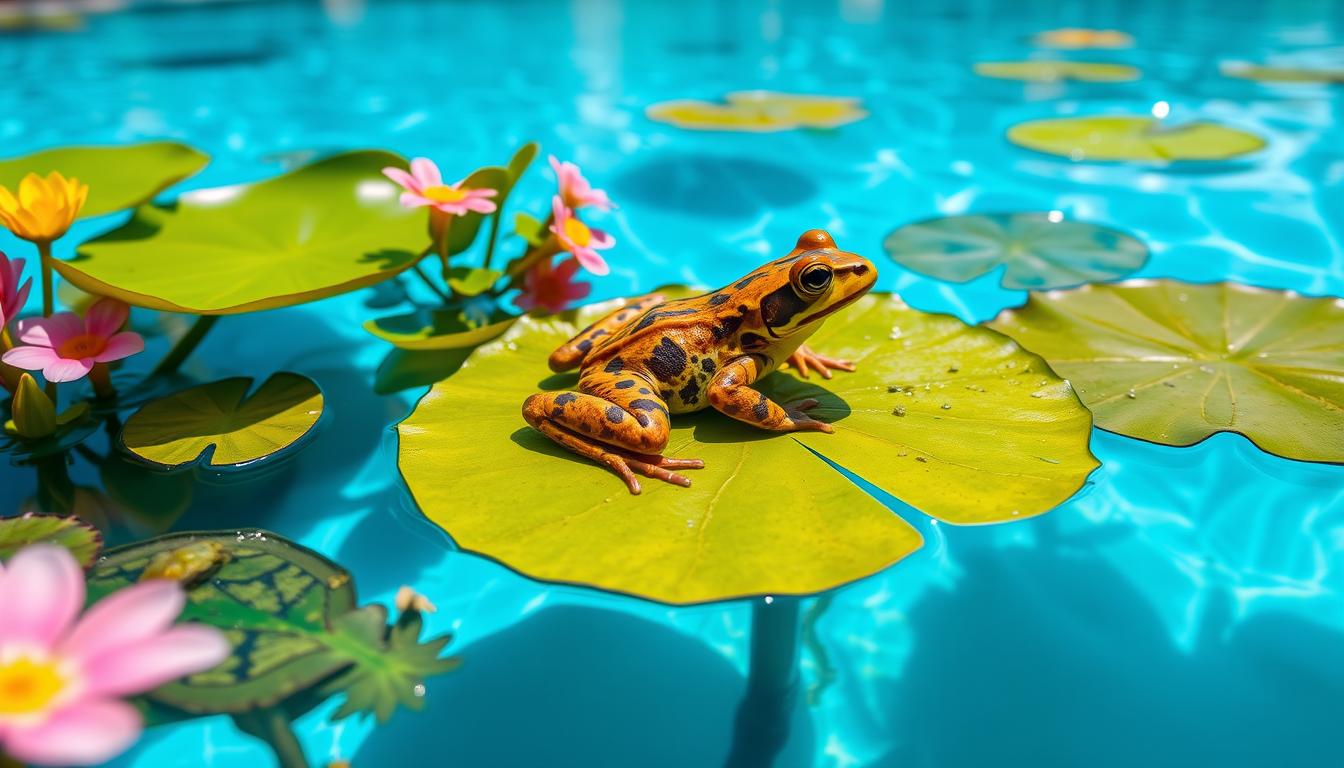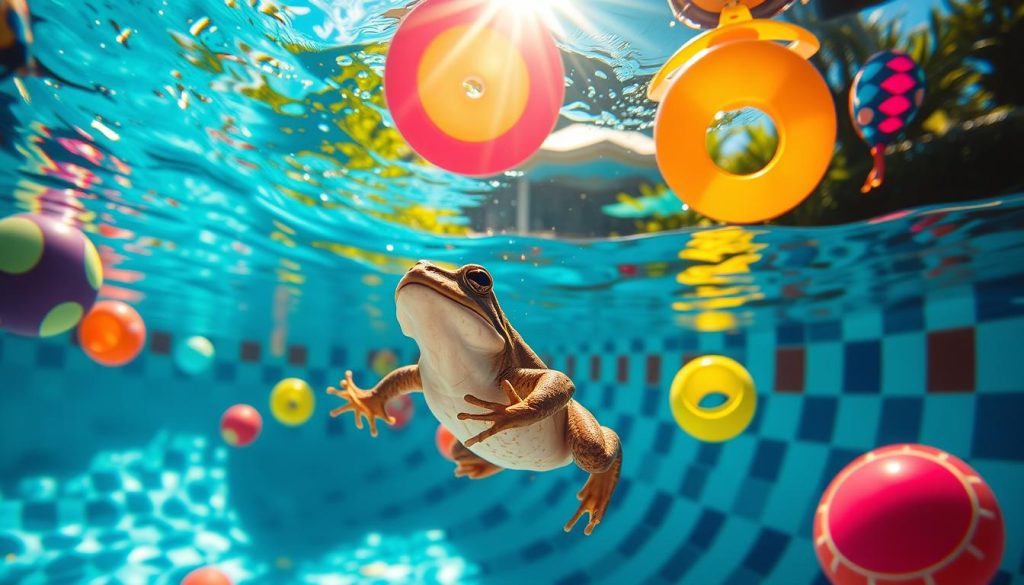
Frogs transform from tadpoles to froglets in about three to four months. These amazing creatures undergo a stunning change during their life. When frogs enter pools, it raises worries about their survival and pool health.
We’ll look at what affects a frog’s life in a pool. We’ll also share expert tips on keeping both frogs and your pool safe.
Frogs thrive in natural waters like ponds and streams. There, they find food and care for their delicate skin. Pools, however, pose unique challenges for frogs.
Pool chemicals and barriers make it hard for frogs to survive. Understanding these factors is key to knowing how long frogs can live in pools.
Key Takeaways
- Frogs undergo a three to four-month metamorphosis from tadpole to froglet
- Swimming pools present chemical and physical hazards to frogs
- Chlorinated water can be harmful to a frog’s sensitive skin
- Frogs may struggle to escape from pools due to steep walls and lack of exit points
- Creating a frog-friendly backyard pond habitat can provide a safe alternative to pools
- Safely removing frogs from pools is crucial for their survival and the pool’s ecosystem
Understanding Frog Habitat Requirements and Lifespan
Frogs’ natural habitats and lifespan factors are crucial for pet care and wild population conservation. Understanding amphibians’ environmental needs helps us compare wild and captive frogs. This knowledge enables us to provide the best care for our aquatic pets.
Natural Habitats of Frogs
Frogs live in various habitats, from tropical rainforests to temperate woodlands and wetlands. The American bullfrog (Lithobates catesbeianus) is native to eastern North America. It inhabits every state east of the Mississippi River.
Bullfrogs have been introduced worldwide, including Nantucket, Arizona, Hawaii, Japan, and Europe. In these places, they’re considered invasive species. They can disrupt local ecosystems by outcompeting native fauna.
Frogs often live in canals, using them for breeding and hibernation. The northern pool frog, once extinct in the UK, shows the importance of preserving breeding habitats. Conservationists are now trying to bring this species back to its former range.
Factors Affecting Frog Lifespan in the Wild
Wild frogs face many challenges that affect their lifespan. Predators, diseases, and environmental stressors all impact wild populations. The common frog (Rana temporaria) lives 5 to 10 years in the wild. Females usually live longer than males.
Breeding season is crucial for frog populations and their long-term survival. Female common frogs are slightly larger than males, reaching 6-10cm and 22g. They lay up to 2,000 eggs during breeding season.
Few eggs survive to become adult frogs. Tadpoles face many challenges during their 16-week development. After this time, they lose their tails, grow legs, and become froglets.
The loss of breeding habitats remains a major threat to frog populations, with declines noted in recent years. As human activities continue to encroach upon natural areas, it is vital that we prioritize the protection and restoration of these critical environments to ensure the long-term survival of our amphibian friends.
| Species | Lifespan in the Wild | Breeding Season Duration |
|---|---|---|
| American Bullfrog | 8-10 years | 2-3 months |
| Common Frog | 5-10 years | 3-4 weeks |
| Northern Pool Frog | 6-8 years | 2-3 weeks |
Understanding wild frog lifespans and breeding habitats helps us create better conservation efforts. We can support these fascinating creatures through habitat protection, public education, and research. This work ensures frogs thrive in the wild and as beloved pets.
Challenges Frogs Face in Swimming Pools
Swimming pools can be dangerous for frogs. These man-made waters pose risks to amphibians. Frogs may suffer health issues or even die in pools.
Let’s explore the problems frogs face in pools. We’ll also discuss how to make pools safer for these creatures.
Chemical Hazards in Pool Water
Chlorine in pools is a major threat to frogs. Their permeable skin easily absorbs harmful chemicals. This can cause skin irritation and breathing problems.
Studies show chlorinated water damages frogs’ skin and eyes. It makes it hard for them to survive in pools.
Physical Barriers and Escape Difficulties
Frogs struggle to escape from pools. Smooth, vertical walls make climbing out nearly impossible. This can lead to exhaustion and drowning.
Most pools lack shallow areas or slopes. This traps frogs, leaving them vulnerable.
Predation and Stress in an Unnatural Environment
Frogs in pools are easy targets for predators. The open space offers little protection. Birds and other animals can easily catch them.
The unfamiliar environment stresses frogs. This weakens their immune system, reducing survival chances.
According to recent studies, over 40% of amphibian species globally are threatened with extinction, with populations in the United States declining at a rate of nearly 4% per year. If these trends continue, some species could vanish from up to half of their habitat within a few decades.
Pool owners can help create frog-friendly environments. Regular cleaning and proper chemical levels reduce water toxicity. Installing escape ramps improves frogs’ chances of survival.
Using pool covers prevents frogs from entering. This simple step can save many amphibian lives.
| Challenge | Impact on Frogs | Frog-Friendly Solutions |
|---|---|---|
| Chemical hazards | Skin irritation, respiratory issues, and other health problems | Maintain proper chemical levels, consider alternative sanitation methods |
| Physical barriers | Difficulty escaping, exhaustion, and drowning | Install escape ramps or provide other means of exit |
| Predation and stress | Increased vulnerability to predators, weakened immune system | Use pool covers when not in use, create hiding spots around the pool |
Understanding frog challenges in pools is crucial. By using frog-friendly solutions, we can protect these important amphibians. Our actions can help ensure their survival in our changing world.
How Long Can a Frog Live in a Pool?
Frog survival in swimming pools depends on several factors. Chlorinated water poses unique challenges to frogs, impacting their well-being and longevity. Amphibians are adapted to both land and water environments.
Short-Term Survival in Chlorinated Water
Pool chlorine levels are crucial in determining frog survival. Chlorine can harm frogs’ delicate skin and respiratory systems. High chlorine concentrations can cause chemical burns, dehydration, and respiratory distress.

Some frogs may survive in chlorinated water for a few hours to a couple of days. However, this isn’t sustainable, and the frog’s health will rapidly deteriorate.
Factors Influencing Frog Survival Time in Pools
Several factors can affect a frog’s survival time in a swimming pool. These include pool chlorine levels and other important elements.
| Factor | Impact on Frog Survival |
|---|---|
| Frog Size and Species | Larger, more robust frog species like the American bullfrog may have a slightly higher tolerance to chlorine compared to smaller, more delicate species. However, no frog can thrive in a chlorinated pool for an extended period. |
| Presence of Algae or Organic Matter | If the pool contains algae or other organic matter, it may provide a temporary food source or shelter for the frog, potentially extending its survival time. However, this is not a reliable or suitable long-term solution. |
| Water Temperature | Extreme water temperatures, either too cold or too warm, can further stress the frog and reduce its chances of survival in the pool. |
Even if a frog survives briefly, a pool isn’t a suitable habitat. Chlorine exposure and lack of proper conditions will harm the frog’s health.
As responsible pool owners and wildlife enthusiasts, it is our duty to prioritize amphibian rescue from pools and ensure their timely removal and relocation to a more appropriate natural habitat.
Understanding these factors helps protect frogs in pools. Taking action to prevent their entry or safely remove them is crucial. This promotes the long-term well-being of these fascinating creatures.
Safely Removing Frogs from Swimming Pools
Finding a frog in your pool requires quick action. Use a soft net or bucket to gently scoop it out. Avoid touching the frog with your hands to prevent stress or injury.
After removal, release the frog in a suitable habitat. Choose a nearby pond, stream, or wetland area. Ensure it’s far from homes and roads to prevent its return.
Handle the frog gently to minimize stress and dehydration. If it appears injured, contact a wildlife rescue organization or amphibian vet. Your actions help conserve these important species.
Prevent future incidents by installing solid pool fences. Use pool covers to discourage frog entry. Keep your pool clean and well-maintained to reduce wildlife attraction.
These steps promote harmony between your backyard oasis and local amphibians. By taking preventive measures, you’ll rarely need to rescue frogs from your pool.







